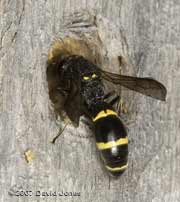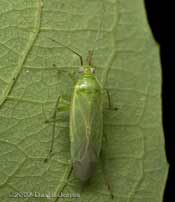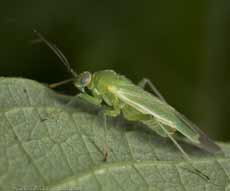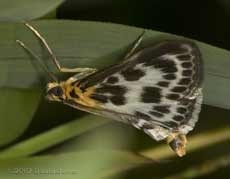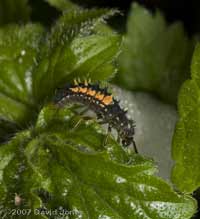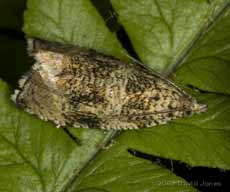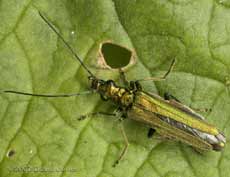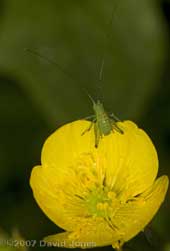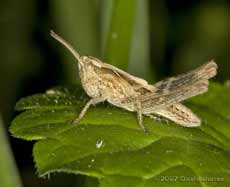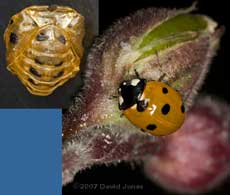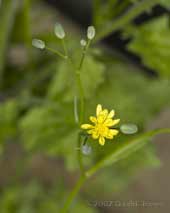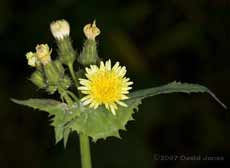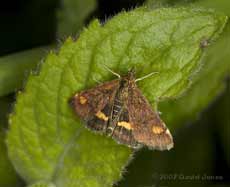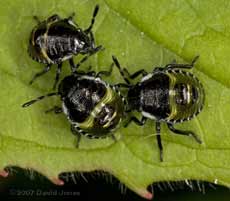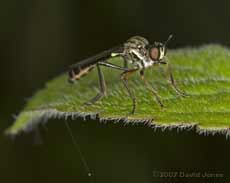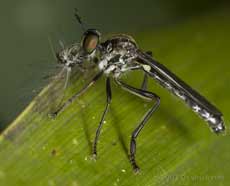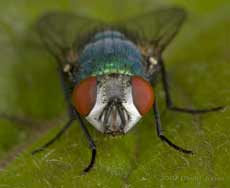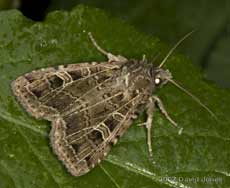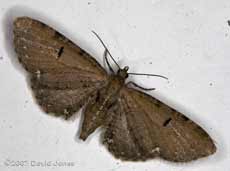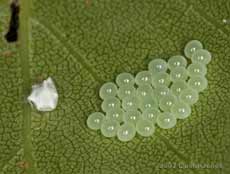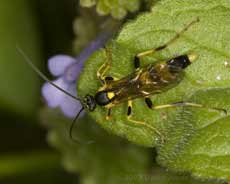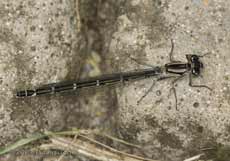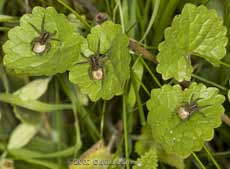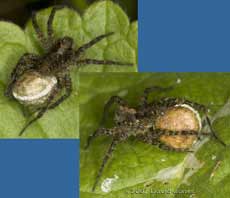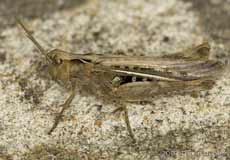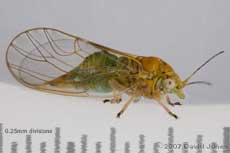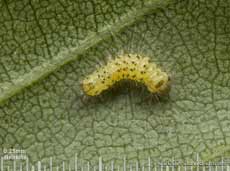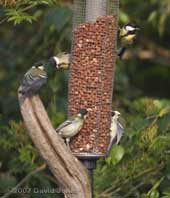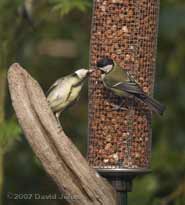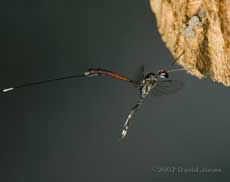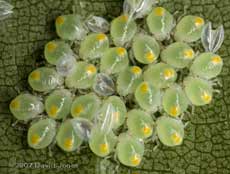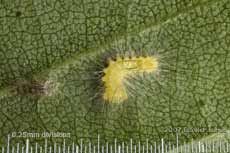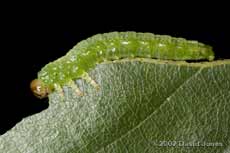Go to the last entry on this page .....Go to previous entry1 June - After a faltering start it turned into bright beginning to the new month, with a high of 22C this afternoon. I needed to to do a few jobs around the house so I didn't do very much with my camera today, but I did get a couple of pictures for the diary.
First is this solitary wasp (still to be identified) that was completing the task of sealing one of the holes in the bee hotel,
and the second insect was what I believe is a Common Green Capsid Bug (Lygocoris pabulinus) on a Willow leaf. This one was just under 7mm in length.
Although partly hidden by the front leg, its quite stout rostrum (leaf-piercing mouth) can be seen pointing back under the body in this side view.
The bee hotel is becoming busy again now with several different species of bees and wasps, so I will be watching out for any new-comers over the weeks to come. I haven't mentioned hedgehogs for a long while, but I should say that they are regulars in the garden every night now, and a couple of times over the last week I have been entertained by their courtship sniffing and snorting. I've refrained from using my camera as they are easily disturbed. At some point I must set up a camera to find out if they are using the hedgehog house under our garden shed.
2 June - A brilliantly sunny morning with cloudless skies and by the end of the afternoon the temperature had risen to 25C - summer has returned!
This is only the second time I have ever seen one of these in the garden - perhaps attracted by the presence of the small patch of nettles under the Ivy tree.
We were out for several hours this evening, and when we returned at about 9.30pm I went out in the garden for a while. Several bats flew over the garden (I must take up the challenge of photographing them!) and for a minute or so I watched a very large beetle flying about overhead. Against the late evening sky I could only see it as a silhouette, but I could see very clearly the huge jaws of a male Stag Beetle. I kept my fingers crossed that it would land, but I eventually lost sight of it in the dark shadows of the Conifers.
This is the first confirmation that a Harlequin has succeeded in laying eggs in the garden, something I have to accept was inevitable after the arrival (and capture) of at least 30 adults this year already. I can't see any others in the same area, but will be checking for them again for time to time.
Another (unidentified) micro-moth this morning, spotted while I was getting in position to photograph the larva.
Thanks to Tim Norriss for identifying this one
as Celypha
During those checks I came across this beetle, which I think may be Oedemera nobilis. If I'm correct, the absence of swollen femora (top section) on its rear legs means that it is a female. Prior to this sighting, I had only seen one in the garden before, back on 17 June 2005, and that was a male.
I also came across 7 Speckled Bush Cricket nymphs (Leptophyes punctatissima), all on Buttercup flowers, and I couldn't resist another photograph.
Back on 11 May I photographed a very young grasshopper nymph. That one could be seen in the same spot for the next five or six days but then disappeared. This more developed nymph has more contrast in its colouring, and you can see its developing wings (absent on the 11 May picture)
On 29 May I 'rescued' a ladybird pupa from my neighbours' garden wall. I thought it was the pupa of a 7-spot Ladybird but wasn't completely sure - I am now as the adult emerged yesterday. It is now somewhere amongst the Red Campions. The larva that I photographed that same day has now transformed into an almost identical pupa, while the pupa found on the Willowherb plant is still to give up its contents. The Harlequin Ladybird larva that I photographed on the 26 May is still to change into a pupa. The temperature reached 15C again today, but it clouded over as the afternoon progressed, and as darkness fell there was a touch of rain in the air. In fact, I see that a severe weather warning for heavy rain has been issued for this evening, for the area just to the east of us.
4 June - A disappointing day after the bright weekend - it was cloudy nearly all day and we had a bit of drizzle during the afternoon. The temperature peaked at 18C during a mid-morning bright spell. A couple of plants to start with, both already in flower -
The first came into flower over the last few days, the delicate Nipplewort. These flowers are a welcome source of food for the smaller bees in the first part of the morning, but they are short - lasting, close before noon, and only open on bright days.
The other flower is a member of the same group, the daisy family (Compositae). It is a Smooth Sow-thistle (Sonchus oleraceus).
There is an absence of butterflies at the moment, and I'm still looking for larger, macro-moths in the garden. Today I saw a Small Magpie Moth again, and this Pyrausta aurata is a regular around the pond.
I've checked the shieldbug larvae that I photographed on 31 May and found that no extra ones hatched out, but there are still 15 larvae grouped around the egg cases. I now believe they are the offspring of a Green Shieldbug (Palomena prasina)
On another plant I spotted this trio of Shieldbug larvae which appear to be a different species, but I need to spend some time identifying it.
I saw several robber-flies today. This one seemed to be sunning itself on a plant next to the big pond,
and this individual was tucking into an aphid meal on a bamboo leaf.
With lots of 'ordinary' flies about, it's easy to just dismiss them, but I always stop to look at the bright colours of flies like this Green-bottle. The contrast between the red eyes and the metallic green of the body stands out, especially in sunshine.
I will be out of action for a short time to get a bit of surgery done - that may mean no diary entries for a few days.
5 June - (written at 2.45am on the 6th!) - Well, I survived my hospital visit for Laparoscopic surgery (Thanks to the Surgeon, his team and the nursing staff at Frimley Park Hospital for their friendly support of a very nervous patient). Checked in around noon, home before 8pm, and as I can't get to sleep tonight I thought I'd add a diary entry to include some photographs taken late in the evening on the 4th.
First of all, having complained about not seeing macro-moths, as I walked down the garden after dark the beam from my torch reflected very brightly from the eye of what I think is a Gothic moth (Naenia typica) resting on an Elder leaf. There are a number of species which are superficially similar, but the Gothic is the nearest match.
The only other moth seen was this smaller (but I cannot recall exactly how big it was) micro-moth on our kitchen door - obviously attracted to the light. I need to look it up before trying to give it a name. Thanks to Richard Clark for letting me know that it is in fact a macro-moth, probably a Currant Pug (Eupithecia assimilata).
Next to them is a curiously shaped silk egg case. I've seen these before on the Birch but have yet to identify what produces them. I have marked the leaf with a bit of red yarn so that I can find it easily and check progress in the days/weeks ahead.
In the aftermath of the operation I have to take things very easy for a few days, and then be careful for up to six weeks, so I may have to restrict the photography I do for the next week or so - at least, avoiding stretching and kneeling to get to those awkward spots. At least I will be able to catch up with adding the large images for the last few days, as well as doing other overdue computer jobs, such as backing up several months' worth of pictures onto DVDs.
It was hunting amongst the plants around the big pond, possibly looking for a caterpillar of a moth of the family Noctuidae. If it is a female it will lay eggs in the caterpillar where they will develop as endoparasites.
The second insect is what I think is a Azure Damselfly female (Coenagrion puella) which was flying low in the garden and using the stepping stones to bask in the morning sunshine.
7 June - A largely overcast day with the occasional brighter spell, although I've been a bit too weary to take advantage of those, let alone catch up with the big picture backlog! And here are a couple more pictures for that list - Back on 11 May I photographed one of numerous female hunting spiders carrying egg cases, attached to their spinners. We continue to see them on the vegetation by the side of the pond, and this group of three caught my eye, each on its own Ground Ivy 'sunbed'.
Looking more closely at the egg cases, I see that each one has a very light ring around its rim now. Does this have anything to do with an imminent emergence, or simply caused by abrasion as the egg case is rotated while being carried?
These spiders are members of the family Lycosidae, and probably the genus Pardosa, but I cannot be more precise. My Collins Field Guide to spiders says that the female frequently open the cases and introduce fluid from their mouth parts before resealing them. I'm not going to try it, but it seems that if the egg cases are taken from them they will readily carry round anything that is of similar size to the case, such as a bit of crumpled paper. I'm checking on these spiders daily as I hope to spot a female with her hatchings on her back after they emerge, which must happen soon.
8 June - A grey start outside, but in here I've been able to get on with a bit of catching up - all the large images are now available for this diary page. The cloud cover broke up gradually and it turned into a bright, sunny day with a high of 22C, the trouble was I was too sleepy to really enjoy it! I'm going to find this convalescence business very frustrating!!!!
When I first spotted it, it was about 7ft up a canvas screen that shields the side of our caravan from sunlight. As I approached, it flew a few yards past me and landed on our concrete parking area, where I took this picture.
9 June - It promises to be a very pleasant, warm and sunny day -
These very small creatures can jump just like leaf-hoppers, and suck sap from plants. They can cause damage the plants and some Psyllids can be serious pests.
I will take another follow-up picture tomorrow, by which time the nymphs may have darkened a bit. The white silk structure is still a mystery, and on a similar thread, the unidentified, pendulous case photographed back on 6 May is still intact.
After taking the picture of the nymphs, on another Birch leaf I spotted this solitary caterpillar, with hairs longer than its body. As is usual when I find something like this, the branch is now marked with a bit of red wool to help me find it again to check on its development.
One snag with my present condition is that I have to be very careful moving about, especially carrying my camera (probably shouldn't!). It does mean that I cannot hope to photograph active subjects, which was a pity this afternoon when I was getting some great views of a Gasteruption jaculator surveying for solitary bee eggs to lay its eggs beside. As it turned out the day was not as sunny as we had expected. Clouds kept things quite hazy for much of the time, and there were even a few spots of rain this evening. However, the temperature still reached over 24C and it became quite humid.
10 June - A brighter day and the temperature was around 24C for much of the afternoon. I was up and about soon after 6am, and spent a pleasant couple of hours outside, listening to the birds before the peace of the morning was interrupted by the first of the power tools in action in the neighbourhood.
They spent ages between the Rowan and the tall peanut feeder, and the group consisted of both parents and six offspring.
The youngsters are in that in between stage when they would peck at the peanuts but were also happy to be on the receiving end of a parent's attention.
Having mentioned the appearance of a G. jaculator yesterday, I did manage one picture of one today as it checked out a bee hotel, although it didn't seem to find a suitable place to lay eggs on this occasion.
A couple of updates on yesterday's pictures. First, another look at the newly hatched bugs. I'm not sure about them being Shieldbugs. The discarded eggs cases are nothing like those of, for example, the Green Shieldbug, whose cases have a very neat 'trap-door' arrangement while these seems to have simply split in half. All 28 eggs hatched - It will be interesting to see how they develop.
The caterpillar has moulted today.
Finally, and also on the Birch, this single sawfly larva, positioned along the central vein of a leaf, having completely devoured the upper half.
Click on images to see larger versions |
|
